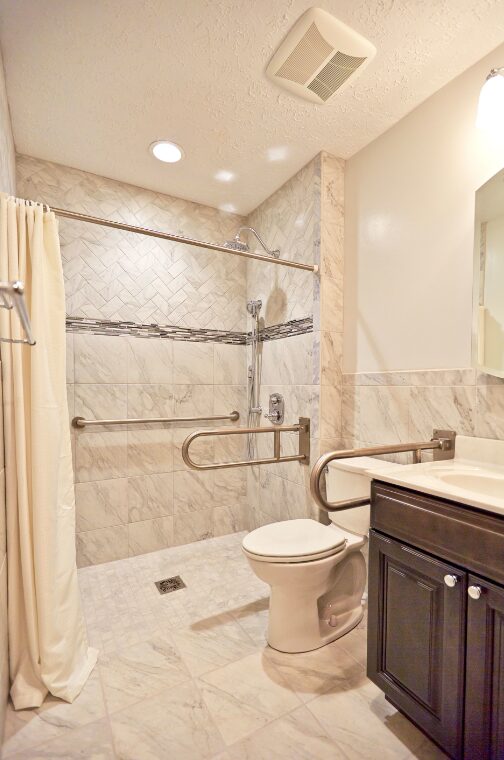If you want to make your home more accommodating for people of all abilities, you may need to renovate your home to make it more accessible. If you don’t have the budget to upgrade your entire house, the bathroom is a great place to start. Here are eight ways you can upgrade your bathroom to ensure it’s more accessible for seniors or anyone with differing abilities.
1. Add a bathroom to the first floor
Having a bathroom on the first floor can make it easier for seniors and those with disabilities to safely use the facilities.This might seem like a major project, but if you currently have to help a relative up the stairs every time they need to use the restroom, this renovation will make life more convenient for everyone.
2. Expand your bathroom
Even if your bathroom is in a convenient location, it’s not helpful if it’s not accessible to someone in a wheelchair or someone using a walker. In some cases, you may be able to reconfigure your bathroom so it’s big enough to accommodate everyone. If not, consider expanding the room. This might be a heavy lift, but if it keeps individuals safe and independent, it’s an investment well worth it. Plus, these upgrades can boost the value of your home.
3. Add a walk-in shower
If an expansion is in your future, increase the square footage of your shower so people using wheelchairs and walking aids can safely maneuver in them. Make sure you add non-slip materials to prevent accidents and leave enough wall space for safety bars and rails, too.
Purchase a transfer chair as well. This chair allows older individuals to easily sit down and scoot into the shower area safely. This lets them bathe more easily without needing assistance getting in and out of their chair.
3. Check your sink’s height
Everyone in your household should be able to safely use and reach the sink. You might need to lower it slightly for someone in a wheelchair. You can invest in a sink that lowers and raises to better accommodate different heights.
4. Raise your toilet
Bending down to squat on a low-to-the-ground toilet can be painful and dangerous for seniors and other individuals with disabilities. A higher toilet can make it easier for them to go to the bathroom independently and without pain.
You can buy a toilet that sits higher up, but if that isn’t in your budget, you may be able to add a raised seat, rather than replacing the toilet entirely. Just make sure everything is put together snugly to reduce the risk of an accident.
5. Widen the doorway
A wider bathroom is no help if individuals struggle to get inside the room. Make sure you expand the doorway to comfortably accommodate wheelchairs, motorized chairs, and other walking aids.
6. Store items within reach
Commonly used items should be easy to access for all individuals. This includes towels, toiletries, toilet paper, toothbrushes, and toothpaste. You might need to lower shelves or store commonly used items on easier-to-reach shelves. If you have drawers built into your sink, make sure they’re easy to open from all heights.
If you have a bathroom closet, don’t store commonly used items up high. Instead, keep them chest level or lower so elderly individuals can easily access them.
7. Don’t overlook flooring
You might love the gorgeous marble tile floor you installed when you bought your house, but it could be a safety hazard. Older individuals are more prone to slips and falls, so preventing that with non-slip flooring is imperative. That doesn’t mean you need to pry up your beloved tile. You can add non-slip strips across the floor or seal the tile with a non-slip top coat.
Be careful about loose rugs, too. Adhere them to the floor with tape or strong rug pads.
8. Add grab bars and rails
Another way to make your bathroom accessible is to add grab bars. These can be a helpful way to ease yourself down into a sitting position and get back up again, whether you’re in the shower or on the toilet. They can also offer seniors something to hold onto as they walk to prevent falls. Make sure the grab bars are at a comfortable height for most individuals and that there are enough to ensure seniors stay safe.
Not sure which accessibility project to start first?
If you’re selling your home soon, contact a real estate agent to learn which bathroom accessibility features are the most valuable to buyers. If you don’t have the money saved for a major upgrade, you can build a renovation fund with a high-yield savings account. Look for bank accounts with minimal fees, high annual percentage yields and bonuses to grow your renovation money even faster.
Aging in Place: How to Help Your Parents Stay in Their Home






